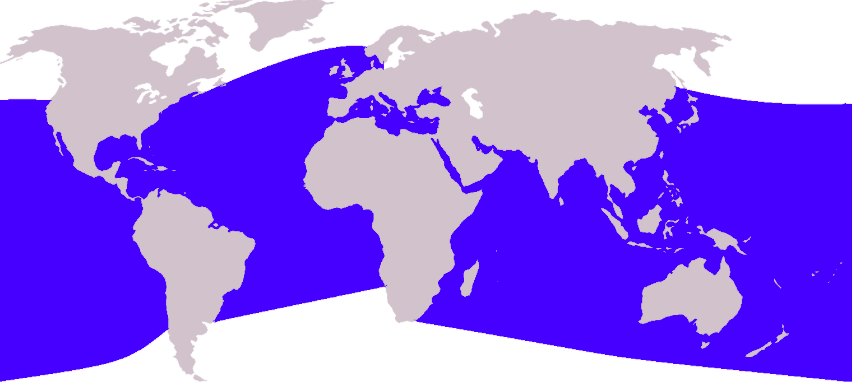The Bottlenose Dolphin
Jonathan
Description
The Bottlenose Dolphin is a mammal that can be found in tropical waters. Their skin colour is grey. The Bottlenose Dolphin has a wide head and body, a short round beak and long fins. It has marked creases between the beak and its forehead. The farther the Bottlenose Dolphin lives from the shore the more different it looks compared to other Bottlenose Dolphins. This particular type of dolphin is 84 to 140cm long at birth and it is averagely 2.45 to 3.8m long. The Bottlenose Dolphin can live up to 50 years.

Habitat
The Bottlenose Dolphin lives in the tropical waters in the ocean and sometimes lives in peripheral seas. It can live near the coast or in the middle of the sea. Not only can the bottlenose dolphin live in oceans, it can also live in: bays, rivers and estuaries. The water has to be 10 - 32°C for the bottlenose dolphin to survive.

Predator Adaptations
Bottlenose dolphins use echolocation to locate prey and to create a picture of their surroundings. Echolocation is to find the location of an object by the echoes of (in this case) the dolphin’s surroundings. The bottlenose dolphin makes clicking sounds and then waits for the echo to return from the objects that are surrounding them. By hearing this echo, they can tell how far away the object is and how large it might be. When bottlenose dolphins work together and travel in a group, they can easily trap schools of fishes like mackerel or squids by gathering them together and diving into the prey to feed.
Prey Adaptations
Sharks like the Tiger Shark, the Dusky Shark and the Great White Shark are all predators to the Bottlenose Dolphin. Killer Whales are predators of the Bottlenose Dolphins as well. The Bottlenose Dolphin can defend itself by charging the predator. This behaviour is called "mobbing" and sometimes can kill the predator or make the predator flee. Swimming in groups also allows the Bottlenose Dolphin to better defend themselves against predators. The method of echolocation can be used for prey adaptations as well. Once they know how big the object is the Bottlenose Dolphin choses to attack or flee.

Symbiosis
Humans and Bottlenose Dolphins have created a commensalistic symbiotic relationship. This is one of three symbiotic relationships in which one organism benefits and the other is unaffected. Bottlenose Dolphins help humans by attacking a group of fish forcing the fish to swim away. While the Bottlenose Dolphin is chasing the fish the Bottlenose Dolphin is directing them toward the fisherman. Before the fish realize what is happening to them they get trapped in the humans net. In this case the human benefits and the Bottlenose Dolphin is unaffected.
Species Comparison:The Dugong
Similarities
Both organisms are mammals and are grey. The two species travel in there own groups for a predator adaptation. They also have the same predators like the Tiger Shark and the Killer Whale and their average size is 3 meters. Part of their habitats are the same: they both live in the Great Barrier Reef and in costal waters.
Differences
There are not a lot of differences between the Bottlenose Dolphin and the Dugong. The Dugong is an herbivore, it only eats producers like seaweed. The Bottlenose Dolphin is a carnivore; it eats other consumers like Mackerel and Squids. Part of its habitats are different: The Bottlenose Dolphin lives on the coast of islands and the Great Barrier Reef like Dugongs but the Bottlenose Dolphins can also live in bays, rivers, open waters and estuaries. The dugong lives averagely up to 60 years but the bottlenose dolphin only lives up to about 50 years.


Resources:
Bottlenose Dolphin. Photograph. Encyclopædia Britannica Image Quest. Web. 30 May 2013.http://quest.eb.com/images/130_599441
DUGONG. Photography. Encyclopædia Britannica Image Quest. Web. 30 May 2013.http://quest.eb.com/images/138_1076282
Bottle-nosed Dolphin. Photograph. Encyclopædia Britannica Image Quest. Web. 30 May 2013.http://quest.eb.com/images/130_611363
Australian Museum. Bottlenose Dolphin. October 13 2009. May 21 2013. http://australianmuseum.net.au/Bottlenose-Dolphin/
Odell, Daniel K. "Dolphin." World Book Student. World Book, 2013. Web. 30 May 2013. http://www.worldbookonline.com/student/article?id=ar163280&st=bottlenose+dolphin
Map range bottlenose dolphin. August 31 2009. Wikimedia commons. May 23 2013. http://commons.wikimedia.org/wiki/File:Cetacea_range_map_Bottlenose_Dolphin.png
Reeves, Ronald R et al. Guide to marine mammals of the world. Toronto. Random House Canada. 2002
Paul Thomas and Ben Wilson. Bottlenose Dolphins. St. Paul. MBI publishing company. 2001.
BOTTLENOSE DOLPHINS.. Photography. Encyclopædia Britannica Image Quest. Web. 3 Jun 2013.http://quest.eb.com/images/131_1431163
Comments (0)
You don't have permission to comment on this page.